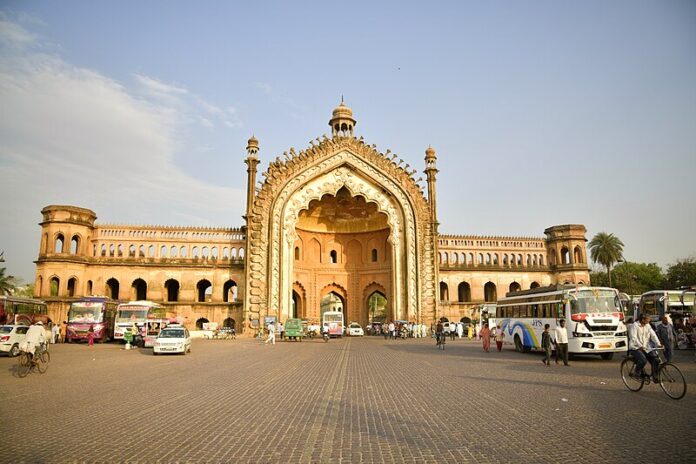Sidra Fatima and Syed Taqui Haider, TwoCircles.net
Lucknow: Nestled in the heart of Lucknow, the capital of Uttar Pradesh, the Rumi Darwaza stands as a breathtaking testament to the city’s rich architectural legacy and cultural achievements. Often dubbed the “Turkish Gate”, this magnificent gateway was constructed in 1784 by Nawab Asaf-ud-Daula, a pivotal figure in Awadh’s history. Positioned between the Chota Imambara and Bada Imambara, it serves as a structural bridge connecting these historical landmarks while embodying both historical significance and artistic grandeur.
The Rumi Darwaza’s creation coincided with a severe famine in Lucknow. Built as a famine relief measure by Nawab Asaf-ud-Daula, it provided employment to thousands during a dire time. Its design drew inspiration from the Sublime Porte in Istanbul, reflecting the profound influence of Mughal and Persian architectural styles in India.
Characterized by its elaborate ornamentation, the Rumi Darwaza epitomizes Awadhi architecture through its grand scale and harmonious fusion of various architectural styles. The gateway features an arched doorway adorned with floral motifs, rising to 60 feet in height and crowned by a central lantern that once guided travellers at night. Often described as a window to the Old City of Lucknow, this architectural marvel symbolises the resilience and artistic spirit of the city.
Architectural Features
The Rumi Darwaza’s architectural style showcases a distinct ‘Nawabi’ flavour, diverging from the Mughal preference for red sandstone. Instead, Nawabi structures like the Rumi Darwaza utilize brick-faced construction with lime plaster, allowing for intricate sculpting that is less feasible with stone. The gate’s detailed floral carvings exemplify the Nawabi penchant for meticulous craftsmanship.
Commonly referred to as the “Turkish Gate” due to its resemblance to Bab-i-Humayun in ancient Constantinople (now Istanbul), the Rumi Darwaza offers a panoramic view of the city from its octagonal chhatri (canopy). The gate’s ornate engravings blend Persian, Turkish, and Mughal elements, showcasing the craftsmanship of the era. Originally, lights were placed in the niches flanking the entrance, enhancing its allure and symbolizing Lucknow’s social and cultural diversity.
Controversies and Challenges
Despite its historical grandeur, the Rumi Darwaza faces significant challenges, including environmental degradation, inadequate maintenance and encroachment.
Aftab Hussain, superintendent at the Archaeological Survey of India (ASI) in Lucknow, detailed the conservation efforts: “Identifying and marking the cracks took months, followed by research to find authentic materials for repairs. Conserving such a large structure is a complex task, requiring meticulous attention to each crack with multiple layers of plaster.”
Pollution, vehicular emissions and vibrations have exacerbated the damage to the gate’s intricate carvings, raising concerns among conservationists. “The vibrations from heavy traffic have caused significant cracks,” Hussain noted.
Recent refurbishments have included adding parks and an old-style brick road to restore the gate’s former glory. However, proposals to modernise the area with flyovers and commercial complexes were met with criticism. Ongoing conservation work has left visitors unable to fully appreciate the structure, leading to frustration among locals and calls for re-evaluation of development plans.
He clarified the detailed documentation process: “The conservation work is time-consuming, and documenting every step, including before and after photos and notes, is essential for future reference.”
Heritage conservationists argue that modernisation could damage the gate’s historical ambiance and integrity, fueling a debate between advocates of progress and preservationists.
Efforts are underway to address these concerns, including proposals to restrict traffic to foot visitors only, which would reduce wear and tear on the structure.
“The Rumi Darwaza is more than a gateway; it represents Lucknow’s architectural brilliance and cultural heritage. Preserving this landmark not only honors the city’s artistic legacy but also supports local tourism,” said Saurabh Tiwari, a contemporary history professor at the Era University, Lucknow.
According to a document from the ASI, “The conservation team explored historical records, photographs and previous conservation works. The process focused on using reliable documentary evidence rather than artistic whims, ensuring that conservation efforts align with the original materials and traditional skills. Rajmistri (mason) from a traditional Lucknow family was employed for this work.”
The Rumi Darwaza remains a symbol of Lucknow’s enduring historical significance and Nawabi architectural heritage, continuing to inspire awe while navigating the challenges of preservation amidst modern development pressures.


